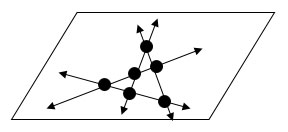D is the midpoint of AC, which of the following conjectures can be made about the relationship between AD and DC?
- AD is longer than DC.
Incorrect. Since D is the midpoint of AC, one segment is not longer than the other.
- AD is congruent to AD.
Incorrect. A line has infinite length, so it cannot be congruent to a segment.
- AD is congruent to DC.
Correct! A midpoint falls in the middle of the segment and forms two congruent parts.
- AD is congruent to AC.
Incorrect. AD is the length of the entire segment and AC only contains half of the original segment.
If points A, B and C determine plane D, which of the following conjectures best explains the relationship among points A, B, and C?
- A, B, and C are collinear because they are in plane D.
Incorrect. A, B, and C are noncollinear because of the postulate that states through any three noncollinear points there is exactly one plane containing them.
- A, B, and C intersect plane D as a line and therefore are collinear.
Incorrect. A, B, and C are noncollinear because of the postulate that states through any three noncollinear points there is exactly one plane containing them.
- A, B, and C are noncollinear because they intersect plane D as a line.
Incorrect. “Noncollinear” means that three points are not in a line.
- A, B, and C are noncollinear because a plane is determined by 3 noncollinear points.
Correct! This is the postulate defining a plane.
What is the greatest number of intersection points four coplanar lines can have?
A. 4
Incorrect. Look at a picture to test your conjecture. 
B. 6
Correct! Four non-coincident lines can intersect in at most 6 places.
C. 2
Incorrect. Look at a picture to test your conjecture. 
D. 0
Incorrect. Look at a picture to test your conjecture. 
In the figure, AD is 24 feet. What is AB in terms of x?

- 14 3
Incorrect. Remember the total segment length is 24, so AB is equal to 24 – (9 + 3x + 1).
- 13 − 3x
Incorrect. Remember the total segment length is 24, so AB is equal to 24 – (9 + 3x + 1).
- 3x + 1
Incorrect. Remember the total segment length is 24, so AB is equal to 24 – (9 + 3x + 1).
- 14 − 3x
Correct! You successfully subtracted the lengths of BC and CD then simplified the expression.
Points A, B, C, and D lie on the same line, in order, and AB ≅ CD, as shown in the figure below.

Is it true that AC ≅ BD? Explain.
- Yes. AC ≅ BD because they each contain BC and one of two other congruent segments.
Correct! Great job.
- There is not enough information to conclude a relationship between AC and BD.
Incorrect. What segment is contained in the overlap between AC and BD?
- No. AC < BD, since A and C lie farther to the left on the line, and numbers on the left end of a number line are less than numbers on the right end.
Incorrect. The points lie on a line, but this isn’t necessarily a number line.
- No. AC ≠ BD. AB ≅ CD but BD does not equal CD, so AC = BD cannot be true.
Incorrect. It is true that BD ≠ CD, but that does not necessarily mean that AC ≠ BD.





